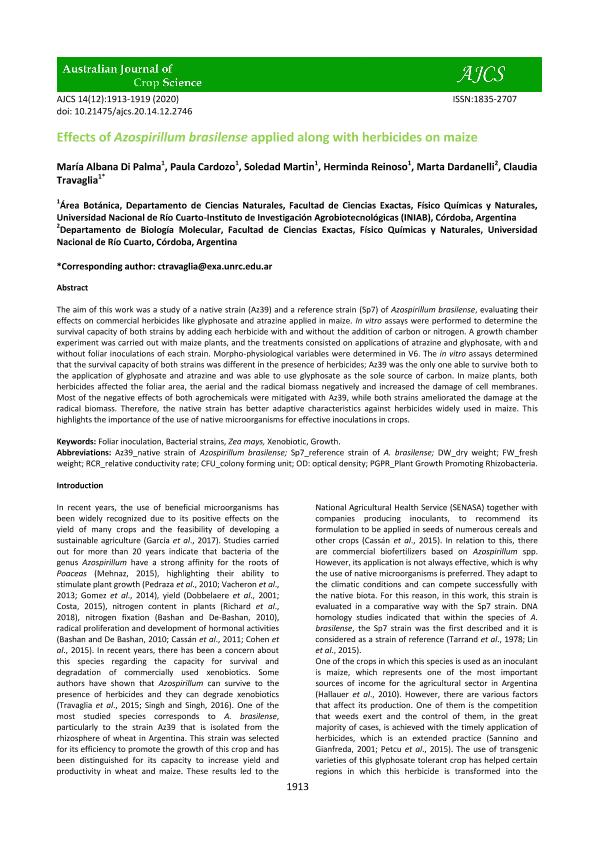Artículo
Effects of Azospirillum brasilense applied along with herbicides on maize
Di Palma, María Albana ; Cardozo, Paula Gabriela
; Cardozo, Paula Gabriela ; Martin, Soledad Marianel
; Martin, Soledad Marianel ; Reinoso, Herminda Elmira; Dardanelli, Marta Susana
; Reinoso, Herminda Elmira; Dardanelli, Marta Susana ; Travaglia, Claudia Noemi
; Travaglia, Claudia Noemi
 ; Cardozo, Paula Gabriela
; Cardozo, Paula Gabriela ; Martin, Soledad Marianel
; Martin, Soledad Marianel ; Reinoso, Herminda Elmira; Dardanelli, Marta Susana
; Reinoso, Herminda Elmira; Dardanelli, Marta Susana ; Travaglia, Claudia Noemi
; Travaglia, Claudia Noemi
Fecha de publicación:
12/2020
Editorial:
Southern Cross Publishing
Revista:
Australian Journal of Crop Science
ISSN:
1835-2693
e-ISSN:
1835-2707
Idioma:
Inglés
Tipo de recurso:
Artículo publicado
Clasificación temática:
Resumen
The aim of this work was a study of a native strain (Az39) and a reference strain (Sp7) of Azospirillum brasilense, evaluating their effects on commercial herbicides like glyphosate and atrazine applied in maize. In vitro assays were performed to determine the survival capacity of both strains by adding each herbicide with and without the addition of carbon or nitrogen. A growth chamber experiment was carried out with maize plants, and the treatments consisted on applications of atrazine and glyphosate, with and without foliar inoculations of each strain. Morpho-physiological variables were determined in V6. The in vitro assays determined that the survival capacity of both strains was different in the presence of herbicides; Az39 was the only one able to survive both to the application of glyphosate and atrazine and was able to use glyphosate as the sole source of carbon. In maize plants, both herbicides affected the foliar area, the aerial and the radical biomass negatively and increased the damage of cell membranes. Most of the negative effects of both agrochemicals were mitigated with Az39, while both strains ameliorated the damage at the radical biomass. Therefore, the native strain has better adaptive characteristics against herbicides widely used in maize. This highlights the importance of the use of native microorganisms for effective inoculations in crops.
Palabras clave:
BACTERIAL STRAINS
,
FOLIAR INOCULATION
,
GROWTH
,
XENOBIOTIC
,
ZEA MAYS
Archivos asociados
Licencia
Identificadores
Colecciones
Articulos (INIAB)
Articulos de INSTITUTO DE INVESTIGACIONES AGROBIOTECNOLOGICAS
Articulos de INSTITUTO DE INVESTIGACIONES AGROBIOTECNOLOGICAS
Citación
Di Palma, María Albana; Cardozo, Paula Gabriela; Martin, Soledad Marianel; Reinoso, Herminda Elmira; Dardanelli, Marta Susana; et al.; Effects of Azospirillum brasilense applied along with herbicides on maize; Southern Cross Publishing; Australian Journal of Crop Science; 14; 12; 12-2020; 1913-1919
Compartir
Altmétricas



